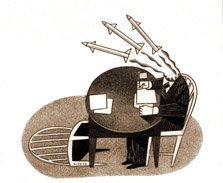
Joseph Perkins
Manhattan Project
http://www.jewishworldreview.com --
WHEN WORLD WAR II began six decades ago, with Germany's invasion of Poland on Sept. 1, 1939, the biggest fear of this nation's political and military leadership was that Adolf Hitler would successfully build an atomic bomb.
Indeed, refugee physicists here in the United States warned that German scientists had discovered nuclear fission in 1938 and that it was theoretically possible to harness that power in the form of the most destructive weapon in the history of the world.
Recognizing this grave threat to U.S. national security -- even though this country would not meet the German Wehrmacht in battle until two years after the start of World War II -- President Franklin Roosevelt approved the creation of the Manhattan Project.
It was the most ambitious scientific-military undertaking in American history. To start from scratch and build an atomic weapon. And to build it before the Germans, who had a three-year head start.
Most of the nation's best and brightest scientists worked on the Manhattan Project, led by the renowned physicist J. Robert Oppenheimer. And after three years of trial and error at the Manhattan Project's compound in Los Alamos, N.M., the United States successfully tested the world's first atomic bomb.
Now, here we are, 60 years later, and the United States finds itself facing a threat to its national security that may eventually become as grave as the Third Reich's race to develop the atomic bomb.
That is: the growing number of authoritarian regimes -- including China, North Korea, Iraq and Iran -- that either have or are actively developing nuclear missiles with which they can threaten America's strategic allies, if not this country itself.
Much as the United States created the Manhattan Project to concentrate the efforts of this nation's best scientific minds to build the first atomic bomb, there needs to be a similar project, here and now, to develop and deploy a missile-defense system that can protect the United States and its allies -- including Taiwan, Japan and Israel -- from nuclear missile attack.
Our allies agree. Indeed, just this week, Japan agreed to conduct joint research with the United States on a missile-defense system that could destroy incoming ballistic missiles like the one North Korea is about to test (against the wishes of both Japan and the United States).
 |
The foes of missile defense in this country, many of whom supported unilateral disarmament back before the Cold War ended, continue to argue that a missile-defense system won't work. They liken the interception of an enemy missile to a bullet hitting another bullet.
But there were similar doubts about the technological feasibility of the atomic bomb back in 1939 before the Manhattan Project came into being. And in only a matter of years, American scientists disproved the skeptics by successfully exploding the weapon in the New Mexico desert.
Similarly, the Pentagon has recently proven that it is, indeed, possible to intercept a missile with another missile. Earlier this month, in fact, the military tested its THAAD (Theater High-Altitude Area Defense) rocket at White Sands Missile Range in New Mexico. The rocket zeroed in on a mock enemy "missile" 50 miles into space and destroyed it.
It "was probably one of the watershed events in the technological history of our country," said Air Force Lt. Gen. Ronald T. Kadish. Foes of missile defense were, nonetheless, unimpressed. It's one thing to knock out one enemy missile, they say, but it's quite another to pinpoint and destroy a number of hostile missiles at the same time.
But that's not the way America's potential adversaries see it. Indeed, China, Russia and North Korea, for instance, obviously believe that the United States is scientifically and technologically capable of developing a full-blown missile-defense system; otherwise, their leaders wouldn't seize every opportunity to decry U.S. research and development in that area.
The United States understood how vital it was to national security to win the race with Nazi Germany to build the atomic bomb. It is no less important today that the United States win the race to deploy an effective anti-missile defense before some unfriendly country or another -- like China, North Korea or Iraq -- decides to fire a nuclear missile at the United States or one of its
JWR periodic contributor Joseph Perkins is San Diego Union-Tribune columnist
and a
television
commentator. Send your comments to him by clicking here.
08/13/99: Tempest in the PETA pot
08/05/99: Utilizing junk science for big payoffs

